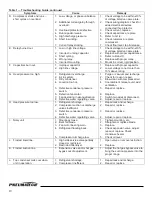
5
A. Install the dryer INDOORS in an area where the
ambient temperature will be above 55°F (13°C) and
below 100°F (38°C). Temperatures below 55°F
(13°C) and above 100°F (38°C) may cause erratic
operation of the air dryer. Air-cooled dryers must be
installed INDOORS in a location with proper
ventilation which will maintain ambient temperatures
as specified above.
B. Position the dryer to permit free circulation of cooling
air through the condenser. Keep two feet minimum
clearance space around the dryer, and also on the
top for servicing. Lack of ventilation can build up the
room temperature by recirculating the same cooling
air through the condenser over and over again. This
will eventually shut down the refrigerant compressor
on high head pressure and/or on internal overload.
C. Connect the compressed air to the dryer inlet.
Connect the plant compressed air line to the dryer
outlet. A three-valve bypass around the dryer is
recommended for dryer service. See Figure 1. A
coalescing afterfilter is recommended for oil-flooded
air compressor systems.
D. Make sure when piping is in place that no undue
stress is placed on dryer connections. Union joints
or flexible connections are recommended to relieve
stress. Also, properly support the pipes as needed
with hangers or brackets. Air piping must be
installed by an experienced pipefitter.
E. An aftercooler (air-cooled or water-cooled) must be
installed between the air compressor and the dryer.
Installing the dryer without the proper aftercooler will
bring high inlet temperature compressed air to the
air dryer which will cause premature failures.
Aftercoolers must be followed by a separator and an
automatic drain to remove the condensed moisture
before the compressed air reaches the air dryer.
If the condensed water is not removed at the
aftercooler/separator/drain, it will reduce the cooling
capacity of the air dryer. Aftercoolers will condense
approximately 2-1/2 to 3 times more water than that
of the air dryer.
F. For models AD-750 through AD-3200, electronic
timer operated drains are standard. All dryers
include a particle strainer upstream from the drain
valve. To clean, close the shut-off valve and
depressurize the drain line.
All drain outlets may be combined for condensate
disposal. Dispose the condensate in compliance to
local and federal government requirements.
WARNING
Drain outlet tubing will periodically contain
pressurized air. An unsecured drain tube will whip
around potentially causing bodily injury.
CAUTION
Do not combine any two or more drain inlet lines
through one single automatic drain valve. This will
reduce or eliminate the proper drainage.
G. For water-cooled air dryers, connect cooling water
lines to the water-cooled condenser from the water
supply. Water pressure must be a minimum of 35
PSIG. Do not connect city water to a condenser
which is piped for tower water or vice versa.
Strainers are recommended at the water inlet to the
condenser. Proper chemical treatment is
recommended for cooling tower water to avoid
scaling and sludge inside the condenser.
CAUTION
Do not reduce pipe sizes connected to water and
drain lines. They should be the same or larger than
sizes supplied on the dryer to avoid excess pressure
drop.
Summary of Contents for AD Series
Page 15: ...14 FIGURE 6 FLOW DIAGRAM AD 750 to 1000 ...
Page 16: ...15 FIGURE 7 FLOW DIAGRAM AD 1200 to 2000 ...
Page 17: ...FIGURE 8 FLOW DIAGRAM AD 2500 to 4000 16 ...
Page 22: ...21 ...
Page 23: ...22 ...







































